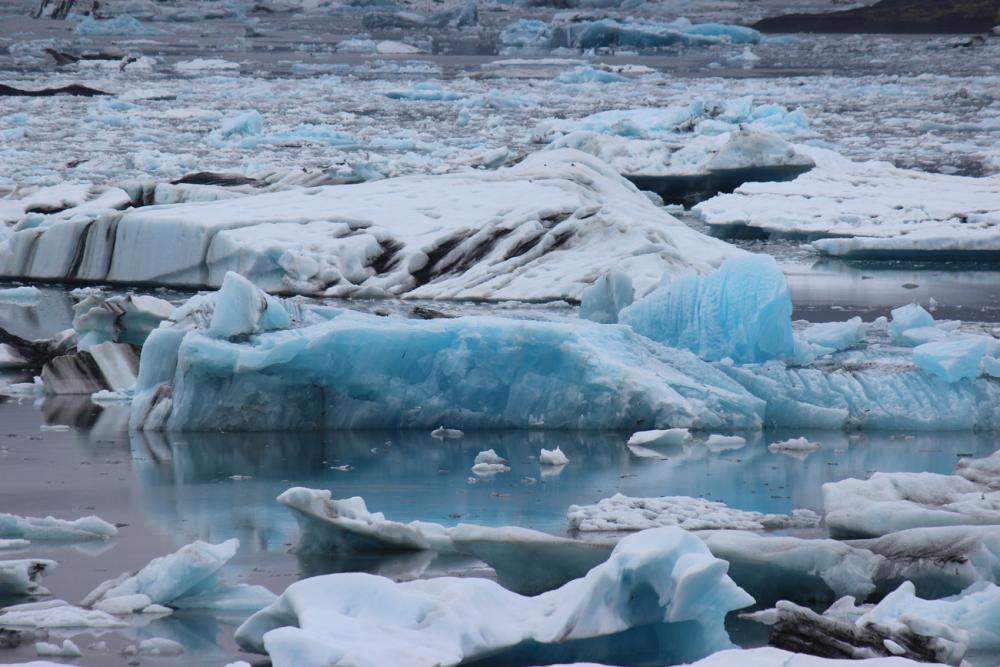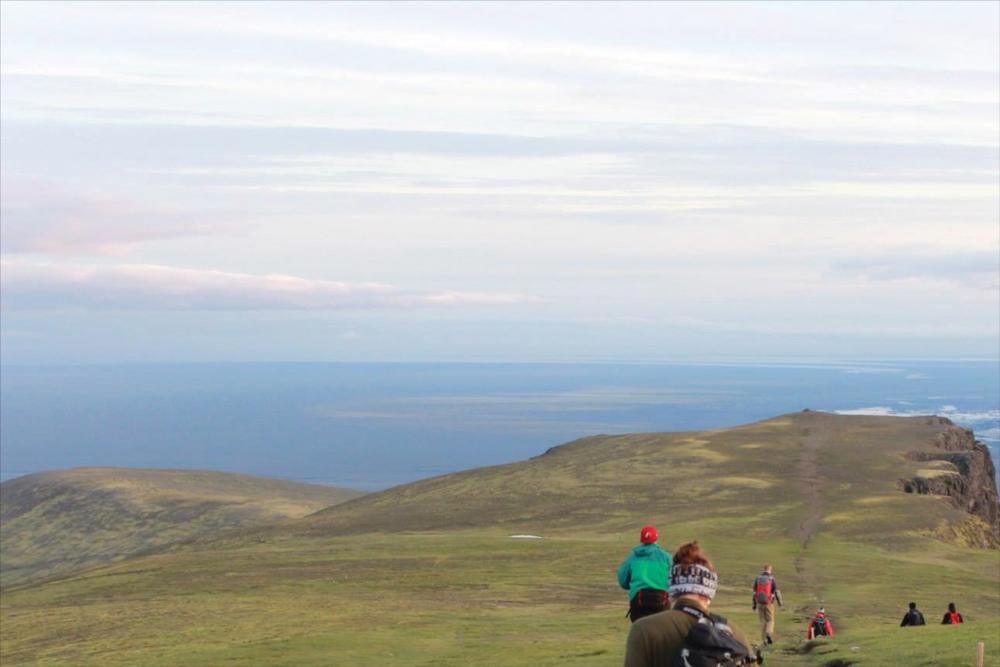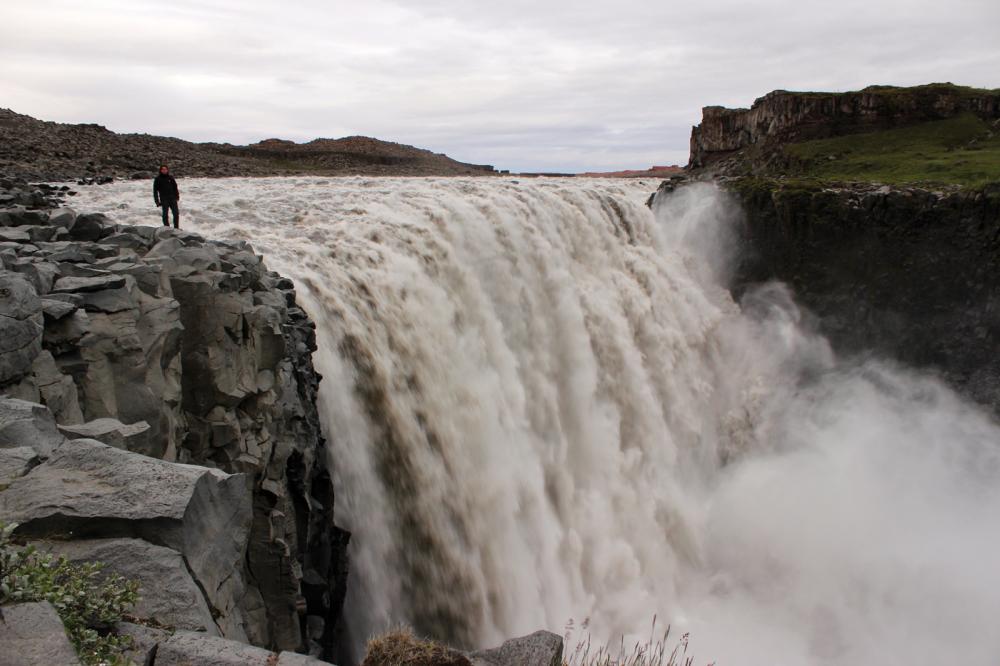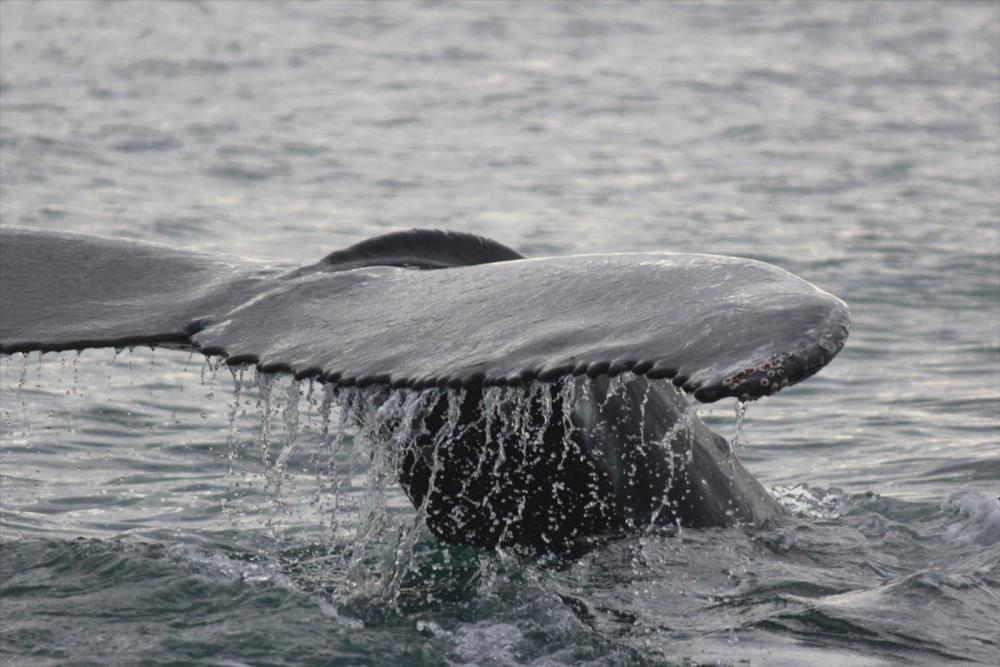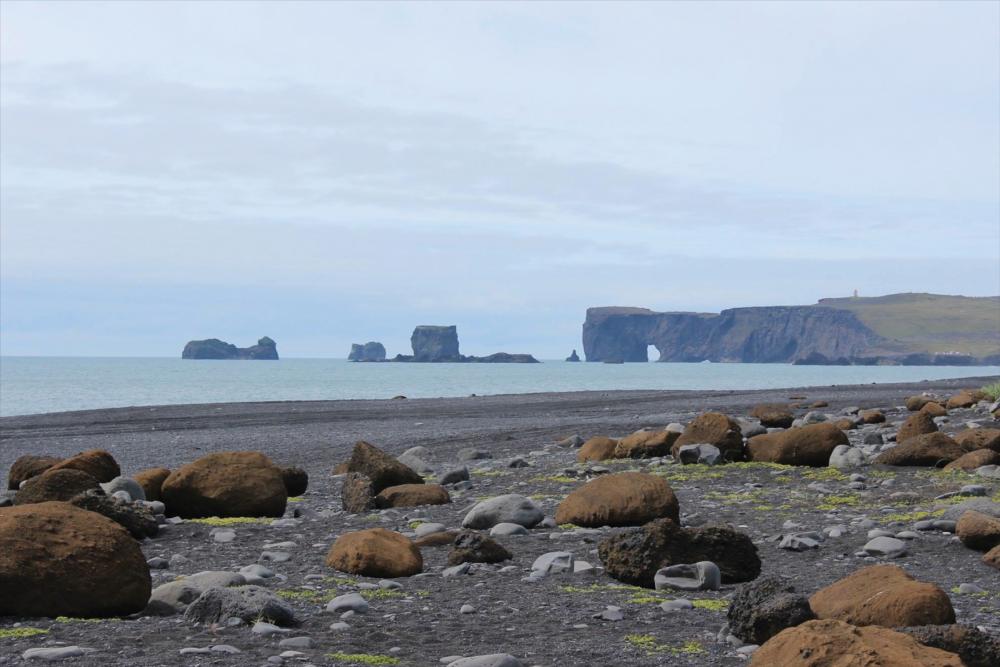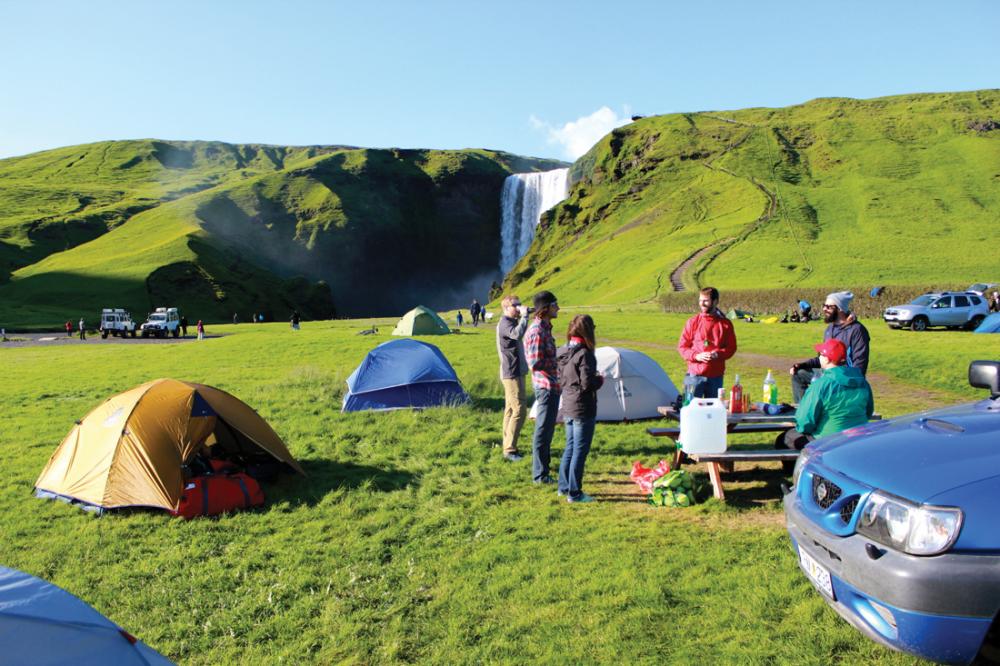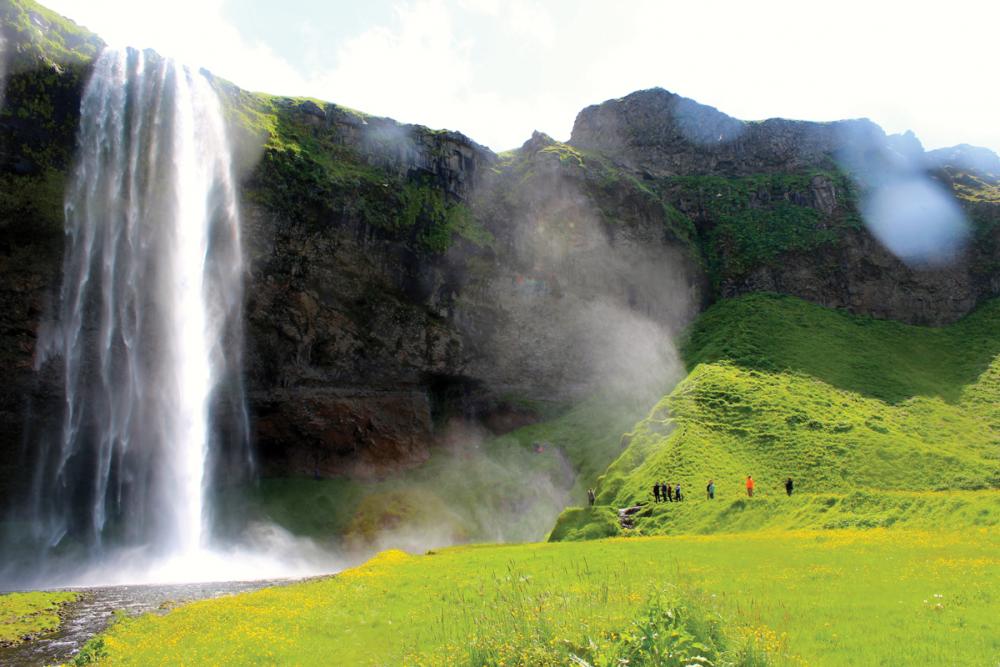After arriving and touring for six days around Iceland, we pulled into Stykkishlmur, a small fishing town in the western part of the country. The road into town was down a hill, ending at a beautiful harbour over-shadowed by a lighthouse atop a cliff. A campsite was located back up the hill at the outskirts of town.
We set up our tents, and moved a picnic table away from all the other campers – using the washrooms as a natural sound barrier. We began preparing our regular meal of gravlax, canned lobster soup, freeze-dried instant meals and warm beer.
It wasn’t long before a trio of Icelanders joined our table: Sds Ragna Inglfsdttir, Atli Mr Gufinnsson, Katrin Sara Reyes. After introductions and the necessary toasts (skl!), Inglfsdttir, the brave woman who originally approached our table, asked where we were from.
“Canada,” I replied.
“Oh, where in Canada? Montreal? Toronto? I have a friend in Ottawa,” she said.
“I’m from Edmonton.”
“I do not know where that is.”
The conversation was cut short by a diminutive Parisian asking us if we could keep the noise down. It was 3:30 a.m. but, as the sun doesn’t set in the sub-Arctic, we were staying on Edmonton time – apparently so were most Icelanders much to the Parisian’s chagrin. Our failed attempts at communication with the Parisian only seemed to enrage him further. Finally, Inglfsdttir took control of the situation. She had studied French as an exchange student in France.
After we parted paths with the Parisian, Inglfsdttir asked, “are you sure you’re Canadian? You don’t speak French.”
Iceland has always fascinated me. It does everything a bit differently. Its economy collapsed and it nationalized its banks, then arrested the bankers responsible for the downfall. The world puzzles over clean energy solutions, and Iceland runs on geothermal energy. Iceland’s solutions are unique and can’t work anywhere else. I wanted to meet the people responsible for this strange country.
In September of 2013, Icelandair announced it would start offering direct flights from Edmonton to Reykjavik, Iceland – linking these two unique northern cities. By December 10, 2013, my fiance and I, along with seven of our friends, had booked our flights for June 21, the summer solstice.
By March, Iceland erupted in Edmonton. All my friends wanted to go, were going, or knew someone who was (obviously). The inaugural flight had Iceland’s Prime Minister, Sigmundur Dav Gunnlaugsson, flying in to meet Mayor Don Iveson -followed by Taste of Iceland at Characters Restaurant and Reykjavik Calling, a concert series at the Starlite Room. A new fishmonger from Iceland had a booth at the City Centre Farmers’ Market and Jonsson’s Icelandic Rice Pudding was being sold at Ma-Me-Oh Beach. Iceland appeared to be everywhere. I already had a nightstand full of literature: The Sagas of the Icelanders, Journey to the Centre of the Earth by Jules Verne and Independent People by Halldr Laxness, winner of the 1955 Nobel Prize in Literature. I knew the list was a bit dated. Hemingway had taught me, “If you want to know about a culture, spend a night in its bars.” I just wanted to have something to talk about when I got there.
The Icelandic Sagas would have been enough to get me excited about Iceland. Tales of epic struggle and sardonic wit bound by a love of language, grit, and poetry. You could travel around Iceland and visit the spots featured in the Sagas. You can see from Stykkishlmur (the small fishing town where we camped) the mountain Helgafell, the burial place of the heroine Gurn svfursdttir from The Icelandic Sagas. You can tie mythos to place in Iceland – stories become locations. Laxness’ Independent People takes the sagas and epic poems and reflects them inwards. The locations and landscapes of waterfalls, volcanoes and glaciers shape the people of Iceland. You can’t help but relate to the result of landscape and population, vastness and isolation. It feels almost Canadian. We live in a country of 35 million people in an area of 10 million square kilometres. Iceland has 320,000 people and an area of 100,000 square kilometres – roughly the same population density per square kilometre.
By the time I started re-reading Journey to the Centre of the Earth, I was obsessed. I needed to see Iceland and meet Icelanders.
When we arrived in Reykjavik, after driving in from the airport, I half suspected there would be a sign: Welcome Edmonton. There wasn’t. We drove the ring road counter-clockwise around the entire country. The landscape was overwhelming: Rich green mountainsides with interwoven patches of purple lupin flowers split by cascading waterfalls tapering into black volcanic beaches along the Atlantic Ocean. There were no mosquitoes and the valleys were filled with crofts of sheep and Icelandic horses. The lush, almost dreamlike vegetation would occasionally disappear into a black desert of igneous rocks, the aftermath of a previous volcanic eruption, which at one location melted a glacier and sent a torrent of water so powerful it washed out a bridge.
We didn’t meet anyone who had heard of Edmonton, or the new direct flights. We sat on the patio of Pakkhsi Bistro, a small pub located just below Salka Restaurant facing the harbor in Hsavk, a northeastern town famous for whale watching and Iceland’s first house, built in 860 AD. We drank Gull beer (pronounced with a guttural guh-thh) and served up bottles of locally brewed schnapps, Haustsl, made from lichen. Beer wasn’t cheap in Iceland, but that schnapps was as cheap as dirt and tasted like it. While we mingled with the locals, I tried to describe Edmonton to the young man, Valur Smrason, who had agreed to let us camp in his backyard while we experienced the whales.
I must have done a terrible job describing Edmonton. Valur had concluded from my description that Edmonton was like Texas and because he had always wanted to be a cowboy in Texas, he would love to come to Edmonton. How little Icelanders knew about Edmonton wasn’t as embarrassing as how little I knew about Edmonton. How could I expect anything from them when my knowledge consisted of oil, beef, maybe four bands (two of which are located in British Columbia now), author Todd Babiak and the Edmonton Oilers? With a population just over 320,000, Iceland isn’t a big market for Edmonton. The link, however, of Edmonton to Europe through Iceland has opened up access to millions of people.
“We have many initiatives,” said Erica Brusselers, Communication Specialist for Edmonton Economic Development. “Right now, we are focusing our marketing in Europe through Icelandair.”
Icelandair flies direct to Reykjavik and has more than 20 connections from there to locations all over Europe; the big pushwill be to bring more people from Germany, the United Kingdom and the Netherlands. Iceland will be a tourist hub bridging North America and Europe, which, strangely enough, is also the location of the continental divide between Europe and North America.
When we packed up and left Stykkishlmur for Reykjavik, a two-hour drive south, I arranged to have coffee in Reykjavik with Hugrn sp Reynisdttir, Head of Division at the Ministry of Finance and Economic Affairs and an expert historian. I needed to discover what she felt about Iceland’s tourism boom. Were Edmontonians just invaders and occupiers disrupting a beautiful and mosquito-free paradise?
“Most of my generation have lived abroad,” said Reynisdttir with her mirthful Icelandic accent. “We travel a lot. It’s a small island. We need to get away and see the world.”
When I brought up the question of tourists, she sat up in her seat and smiled.
“It’s good. They provide jobs. They bring money into the country, but we have to be careful,” Reynisdttir said and then paused for a moment. “We need to make some policy about it. How many tourists do we want to have and how do we make it suitable for them? There was an explosion of tourists and we weren’t prepared for that.” Though Iceland was unprepared for the massive influx of tourists (The service stations outside Reykjavik were always sold out of ice for coolers), it was also part of its charm. Many campsites ran on the honour system. You could stand a few feet from the edge of Dettifoss, the most powerful waterfall in Europe. No guards or staff. No barricades other than the occasional four-inch high fence and a tiny warning sign. You could revel in splendor completely alone, but there was always the coinciding danger involved. Help was not nearby. Iceland wasn’t prepared, but it did feel free.
Finally, when Edmonton came up, I was relieved to find that Iceland is thinking about us.
“When Icelandair opened the market to Edmonton it was a huge opportunity for the fish industry because we are now exporting fresh fish to Edmonton. There are many sushi places in Edmonton [Urbanspoon says 81] and it’s not that easy for them to get fresh fish,” Reynisdttir said.
Pat Batten, owner of a fish market in west Edmonton called Ocean Odyssey Inland, recently partnered with Icelandic fisherman Kjartan Andresson to bring fresh fish to Edmonton. Andresson ships 700 pounds of fish to Edmonton every week. Maybe that will begin to raise Edmonton’s profile in Iceland. It’s got a long way to go. “If Icelanders are going to Canada, I don’t know anything about that. Not many Icelanders are aware there is a direct flight to Edmonton because it’s so new,” Reynisdttir explained. “Only about 20 to 30 per cent of passengers on Icelandair are Icelandic. It’s mostly about bringing people to Iceland.” In the summer time, most people in Reykjavik don’t go out until one or two in the morning. The bars are open until 5 a.m. As we met people and walked from pub to pub (they provide to-go cups when you leave a bar), I continued my search to see if anyone knew about Edmonton. At the steps of Dillon Whiskey Bar, located above Chuck Norris Grill on Laugavegur Street, my feeble attempts at describing Edmonton aroused a response outside our group.
“Wooo! Go Oilers,” said the flat-capped man approaching me.
“You know about the Oilers? Where are you from?” I asked.
“New Brunswick. I’ve got family that works in Alberta.”
Of course he did.



